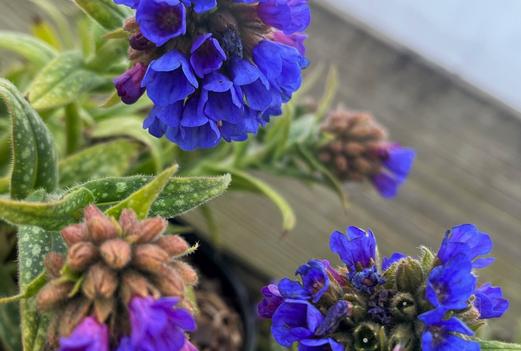In Light of Lungwort
A Brief History of Pulmonaria
This week, we’re going to explore the cultural, ecological, and societal uses of a plant as old as time itself – lungwort, botanically known as the genus Pulmonaria. So, take a deep breath and let us dive in.
The early-blooming, brightly colored inflorescences of lungwort began to greet us in mid-February, gradually pushing their clusters of indigo and magenta flower buds into the balmy winter air. Typically, the bloom time for the various species of Pulmonaria falls within the window of April to May, however the winter protection we offer our perennials, in addition to the mild climate, has allowed for an earlier flower display. In many cases, the early spring blooms provide an excellent source of nectar for hummingbirds that arrive to their post early in the season. The tidy and prolific blooms have been a favorite of gardeners, known to be used as an ornamental as far back as the 16th century. However, records indicate that this dutiful groundcover has roots in history has a prominent medicinal herb. In fact, its medicinal uses are the inspiration behind Pulmonaria’s common name, lungwort.
As the ancient Doctrine of Signatures implies, plants occasionally exhibit similarities to various bodily organs, typically by way of physical attributes, and that plants resembling those parts of the body were capable of healing ailments associated with the aforementioned organs. In this case, the spotted, splotchy, slightly ciliate leaves of Pulmonaria were thought to resemble the textural, membranous appearance of the lungs. The botanical association with this organ is evidenced in the genus name – the root of the Latin word pulmo means “lungs.” In fact, the mucilaginous qualities of lungwort are akin to the mucosal membranes of the lungs, and is traditionally believed to improve respiratory ailments including bronchitis, laryngitis, congestion, cough, etc. Similarly, the mucilaginous properties are also beneficial for the lining of the gut and digestive tract, helping to cool and calm inflamed and irritated tissue. While studies to confirm the medicinal properties of Pulmonaria are still ongoing, there is some evidence that this genus does in fact possess not only anti-inflammatory properties, but anti-bacterial, anti-coagulant, antioxidant, and vulnerary properties as well. Preparation is typically of the aerial portions of the plant utilized in either tea or tincture form when the plant is in bloom.
Ornamentally, lungwort makes for a fantastic addition to the shade or woodland garden where it can be appreciated for flowering early and in moist, damp, shady conditions that other blooming perennials may have difficulty with. Mild winters allow for the speckled leaves to remain semi-evergreen, and in spring the flowers will emerge before the new flush of foliage. A slow-spreading, rhizomatous groundcover, Pulmonaria is wonderful when massed in groups along shaded walkways, edges, or borders, where its flowers and interesting foliage can be appreciated early in the season.
Currently, Pleasant Run offers five different types of Pulmonaria, including Pulmonaria longifolia var. cevennensis, Pulmonaria x ‘Moonshine’, ‘Raspberry Frost’, ‘Raspberry Splash’, and ‘Sissinghurst White’. Each has its own unique quality that makes it a standout in the garden – ‘Moonshine’ for its icy blue
blooms, and ‘Sissinghurst White’ for its blooms that are an overt white, both an outlier from the pink-to-blue hereditary expectancy of naturally occurring Pulmonaria varieties. P. longifolia var. cevennensis boasts nearly fluorescent flowers in the pinnacle of its bloom period, while both ‘Raspberry Frost’ and ‘Raspberry Splash’ nominally indicate softer, reddish-pink-magenta buds and blooms that appear in the early spring.
Chauhan, Shweta, Varun Jaiswal, Yeong-Im Cho, and Hae-Jeung Lee. 2022. "Biological Activities and Phytochemicals of Lungworts (Genus Pulmonaria) Focusing on Pulmonaria officinalis" Applied Sciences 12, no. 13: 6678. https://doi.org/10.3390/app12136678
Foley, M., & Kavakich, F. (2020, October 21). Lungwort: A friend to the inflamed. The Alchemist's Kitchen. Retrieved March 2, 2023, from https://wisdom.thealchemistskitchen.com/lungwort-a-friend-to-the-inflamed/
Heritage Perennials. (n.d.). Pulmonaria longifolia subsp. cevennensis. Plant Profile for Pulmonaria longifolia subsp. cevennensis - Lungwort Perennial. Retrieved March 2, 2023, from https://www.perennials.com/plants/pulmonaria-longifolia-subsp-cevennensis.html
Marie, A. (2022, October 27). Lungwort. The Lost Herbs. Retrieved March 2, 2023, from https://thelostherbs.com/lungwort/
Missouri Botanical Garden. (2023). Pulmonaria 'Raspberry Splash'. Pulmonaria 'raspberry splash' - plant finder. Retrieved March 2, 2023, from https://www.missouribotanicalgarden.org/PlantFinder/PlantFinderDetails.aspx?taxonid=256572
Missouri Botanical Garden. (n.d.). Pulmonaria longifolia subsp. cevennensis. Pulmonaria longifolia subsp. cevennensis - plant finder. Retrieved March 2, 2023, from https://www.missouribotanicalgarden.org/PlantFinder/PlantFinderDetails.aspx?taxonid=253025
Pulmonaria cevennensis. Terra Nova Nurseries, Inc. (n.d.). Retrieved March 2, 2023, from https://www.terranovanurseries.com/product/pulmonaria-cevennensis/
Salerno, N. (2012). Tractatus de herbis. Streets of Salem. Donna A. Seger. Retrieved March 23, 2023, from https://streetsofsalem.com/2012/05/17/the-doctrine-of-signatures/.
See all our Perennials
Pulmonaria longifolia var. cevennensis






